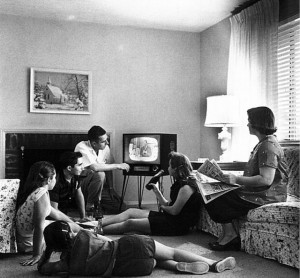An Update on the U.S. Economy
November 19th, 2015 // 2:28 pm @ Oliver DeMille
All in the Family
 A poll by the Pew Research Center shows that, beginning in 2014, the percentage of young women living at home or with family members is the highest since 1940. The number of young men moving home is also growing rapidly, but hasn’t quite topped the 1940 mark yet.
A poll by the Pew Research Center shows that, beginning in 2014, the percentage of young women living at home or with family members is the highest since 1940. The number of young men moving home is also growing rapidly, but hasn’t quite topped the 1940 mark yet.
A significant factor in this shift is that more and more young college graduates are unable to find jobs. Another contributor is that many of the jobs young people do find don’t pay as much as they did for twenty-somethings over the past several decades.
Beyond the college changes, high rent and higher costs of living for everyone are contributing to this change. In short, more young people are staying or moving back home.
Could this be a cyclical return to the multi-generational family households that dominated the 1930s? If so, we would expect to see more grandparents moving in with middle-age children and their families (or vice versa)—and, in fact, this is also occurring. Some eras of history—those with long economic downturns or very slow economic growth—naturally tend toward multi-generational families.
Still Sputtering
Overall, the U.S. economy is still struggling, even though the Great Recession began seven years ago, and even though Washington claims it ended four years ago. But since 2011, we’ve seen only very small growth in the U.S. economy, around 1-2% annually.
For many people, this level of growth doesn’t keep up with the annual increases in their expenses. Many families still feel like the Great Recession never ended, because they seem to be falling further behind. And while the Obama Administration touts the increased numbers of jobs in the past four years, most of these jobs pay much less, and offer fewer benefits (if any), than those so many people lost between 2008 and 2012.
In other words, the recession may technically be over—on paper—but look at the numbers more closely and the economy is still sputtering. Over ninety thousand Americans have now stopped looking for work, so the lower unemployment numbers don’t really mean that lots of jobs—or good jobs—are back.
They aren’t.
The New Economic Normal?
All in all, the Obama Administration has taken the approach that 1-2 percent annual growth for our economy—with lower-paying jobs and more people relying on increased government benefits to survive—is the new normal. The Hillary Clinton and Bernie Sanders campaigns have voiced the same sentiment.
In fact, the Democratic candidates daily make the case that government should offer many more programs (a national $15 minimum wage, free college, increased welfare funds, etc.) so people can get used to making do, even without jobs. Obamacare already did this for health care, though rising costs are causing numerous problems for those who do pay for their own health care.
In contrast, many of the Republican candidates for the 2016 election have argued that we need to get back to 4% annual growth or much, much higher. Whether any of the candidates can win in 2016, and then actually do something to significantly boost the economy, remains to be seen.
We may well be at a national crossroads. If we follow the Democratic path, we’ll increase taxes and depend more on government to help families make ends meet. And paying the bills will be increasingly difficult.
If we adopt the perspective of some Republicans that we really can reboot the economy and spur 4%, 6%, or even higher growth, we can restart the American Dream for the current and next generation. But can any of the Republican candidates actually do it? Only time will tell. At least some of them are trying.
What Actually Works
Let’s be clear. Governments don’t spur economic booms. Entrepreneurs, small businesses, and big businesses that expand and hire do. But when the government regulatory burden and tax rates are as high as they are right now, it’s going to take some government action to free up the economy and incentivize more entrepreneurs and businesses to take action toward major growth.
As for the trillions of dollars held by U.S.-based corporations abroad, the government needs to bring our tax rates down to the point that it makes sense to bring this money back home to the U.S. economy. So, yes, the free economy needs real relief from government right now.
The next election could make all the difference. We’ll either reinforce the Obama legacy and put more people into low-paying (or no) jobs and onto government benefit rolls, or we’ll reboot the economy by freeing it up and incentivizing free enterprise growth, hiring, and expansion.
These are two very clear, opposite directions, and only one of them even has the chance of benefiting American freedom and prosperity in the years ahead. Our economy is at stake.
Category : Blog &Citizenship &Community &Culture &Current Events &Economics &Education &Family &Generations &Government &History &Leadership &Liberty &Politics












Charlotte
9 years ago
We are young people supposed to do? I am one of those struggling young adults trying to raise my baby, living on my husband’s income which barely make ends meet. I am finding myself living on more welfare, which, I feel, takes away my rights and independence. I guess I am living in despair. I have no formal education, but use and follow the TJED daily trying to study on my own. What can do? Where do we turn to?
Easton Kelsey
9 years ago
Charlotte,
There is hope. Join an entrepreneurial community and escape the financial matrix. That’s what we did.